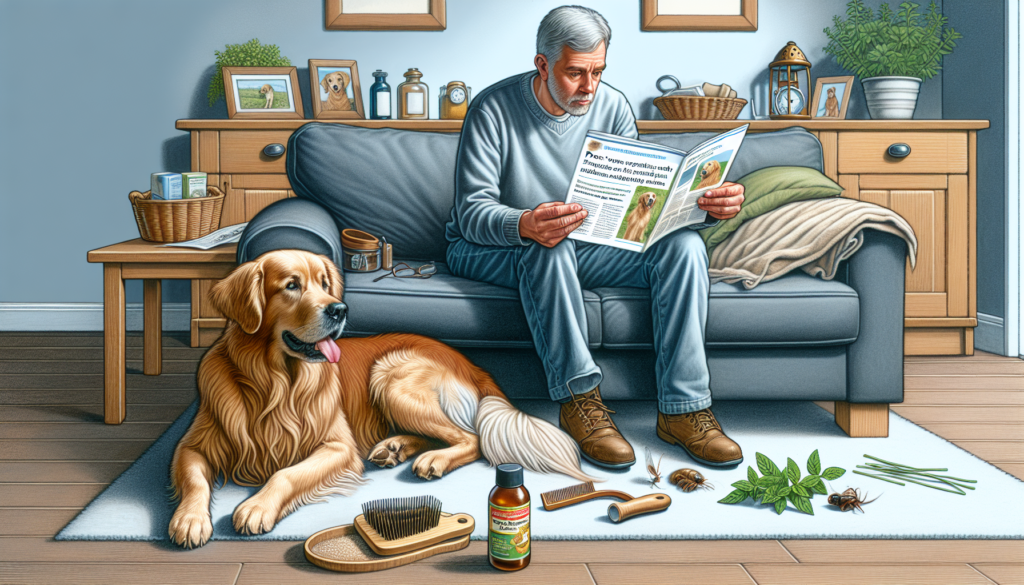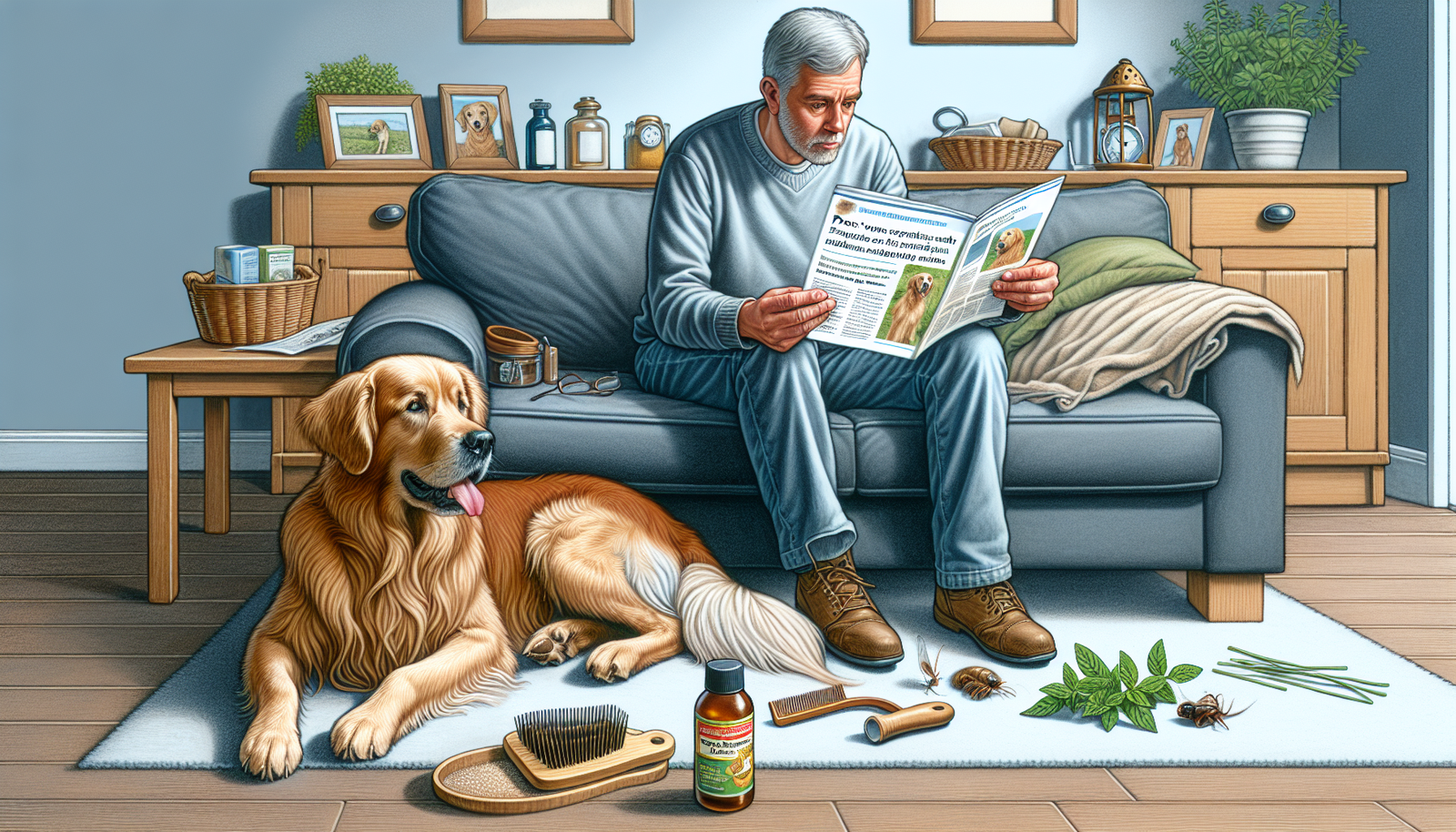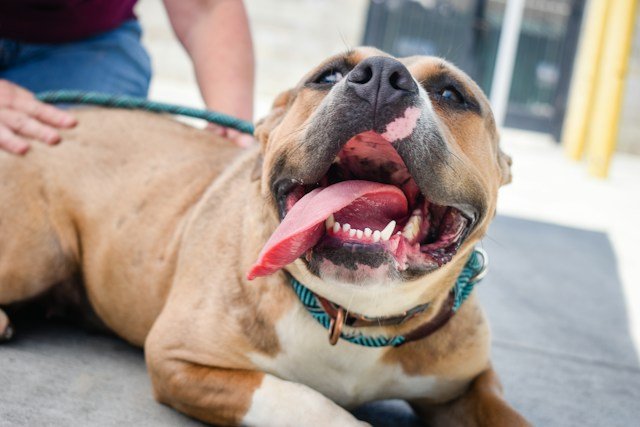Best Ways To Prevent Fleas And Ticks On Your Dog
You adore your furry four-legged friend, but you certainly don’t love when they come home covered in pesky fleas and ticks. These tiny creatures can cause discomfort and potential health risks for your beloved pooch. That’s why it’s important to take proactive measures to prevent fleas and ticks from infesting your dog. In this article, we’ll explore the best ways to keep these nuisances at bay, ensuring your pup stays happy, healthy, and itch-free. So, let’s dive into the world of flea and tick prevention and discover the most effective strategies to safeguard your furry companion’s well-being.
1. Regular grooming
Proper grooming is essential when it comes to preventing fleas and ticks on your furry friend. By incorporating a regular grooming routine into your dog’s care, you can significantly reduce the risk of these pesky parasites infesting your pet and your home.
1.1 Brush your dog’s fur daily
Brushing your dog’s fur daily not only helps to keep them looking their best, but it also helps to remove any loose hair and debris where fleas and ticks may hide. Regular brushing also stimulates the natural oils in your dog’s skin, which can act as a natural repellent for these pests. When brushing, pay close attention to areas like the neck, armpits, and the base of the tail – these are often hotspots for fleas and ticks.
1.2 Bathe your dog regularly
Regular baths are another crucial aspect of grooming that can help prevent fleas and ticks. Use a gentle, dog-specific shampoo and ensure that you thoroughly wash your dog’s coat, paying close attention to the areas where parasites tend to congregate. Remember not to overdo it with bathing, as this can strip away the natural oils in your dog’s skin, making them more vulnerable to these pests.
1.3 Trim your dog’s hair
Keeping your dog’s hair trimmed can go a long way in preventing fleas and ticks. Long, thick fur provides an ideal hiding place for these parasites, making it easier for them to latch onto your dog. Regular hair trimming ensures that your dog’s coat remains manageable and reduces the risk of infestation.
1.4 Use a flea comb
Invest in a good quality flea comb and make it a part of your grooming routine. These specialized combs have finely spaced teeth that can help remove adult fleas and their eggs from your dog’s coat. Comb through your dog’s fur, paying close attention to areas behind the ears, around the neck, and under their legs. Remember to wash the comb in warm, soapy water after each use to prevent spreading any fleas or ticks you may have caught.
2. Keep your house and yard clean
Maintaining a clean living environment is crucial in preventing fleas and ticks from infesting your home. By following these simple cleaning tips, you can greatly reduce the risk of these pests taking hold.
2.1 Vacuum your house regularly
One of the simplest and most effective ways to eliminate flea eggs and larvae from your home is by vacuuming regularly. Pay close attention to areas where your dog spends the most time, such as their bedding, sofas, and carpets. Vacuuming not only removes fleas and their eggs but also helps to eliminate any loose dirt and debris that may attract them.
2.2 Wash your dog’s bedding
Washing your dog’s bedding on a regular basis is crucial for maintaining a clean living environment. Fleas and ticks can easily hide within the fabric of your dog’s bedding and multiply rapidly. To eliminate any potential infestation, wash their bedding at least once a week using hot water and dry it on high heat if possible. This will help kill any fleas, ticks, or eggs that may be lurking.
2.3 Clean outdoor areas
Don’t forget to clean and maintain your outdoor areas as well. Fleas and ticks thrive in warm, humid environments, so be sure to remove any debris or leaf piles that may provide shelter. Regularly mow your lawn and trim any overgrown bushes or shrubs where these pests tend to reside. By keeping your outdoor areas clean, you’ll minimize the risk of fleas and ticks making their way into your home.
2.4 Remove debris and clutter
Inside your home, it’s essential to keep clutter to a minimum. Fleas and ticks love to hide in dark, secluded areas, so it’s crucial to eliminate any potential hiding spots. Keep your floors clear of unnecessary clutter and remove any piles of clothing or blankets that may serve as a cozy hiding place for these pests. By maintaining a tidy living space, you’ll make it more difficult for fleas and ticks to establish a presence.

3. Use flea and tick prevention products
In addition to regular grooming and cleaning, utilizing flea and tick prevention products is a key component in keeping your dog safe from these pesky parasites. Here are some important factors to consider when using such products.
3.1 Consult your vet
Before starting any flea and tick prevention regimen, it’s vital to consult with your veterinarian. They can recommend the most appropriate products for your dog based on their breed, age, and overall health. Your vet will also provide guidance on how frequently to use these products and any potential side effects to be aware of.
3.2 Choose the right product
With a wide variety of flea and tick prevention products available, it’s important to choose one that suits your dog’s specific needs. Some popular options include spot-on treatments, oral medications, sprays, and collars. Each product has its advantages and considerations, so it’s essential to evaluate which option is best for your dog and lifestyle.
3.3 Apply preventative treatments regularly
Consistency is key when it comes to using flea and tick prevention products. Follow the instructions provided by the manufacturer and be diligent in applying them regularly. Skipping a treatment can leave your dog vulnerable to infestation, so it’s crucial to stay on schedule to maintain their protection.
3.4 Use flea and tick collars or sprays
Flea and tick collars or sprays can be a valuable addition to your prevention routine. These products work by releasing substances that repel and kill fleas and ticks, providing an added layer of protection. However, it’s important to choose collars and sprays that are specifically formulated for dogs, as some products intended for other animals, such as cats, can be toxic to dogs.
3.5 Consider oral flea and tick medication
Another effective option to consider is oral flea and tick medication. These medications are typically prescribed by a veterinarian and work by killing fleas and ticks when they bite your dog. Oral medication can provide long-lasting and comprehensive protection, making them a popular choice for many dog owners.
4. Maintain a clean environment for your dog
Keeping your dog’s immediate surroundings clean and hygienic is essential in preventing fleas and ticks. By following these guidelines, you can create a cleaner and safer environment for your furry companion.
4.1 Regularly wash your dog’s bedding
Regularly washing your dog’s bedding is not only important for keeping them comfortable but also for preventing fleas and ticks. Wash their bedding at least once a week using hot water and a mild detergent. This will help eliminate any fleas or ticks that may have latched onto the fabric, reducing the risk of infestation.
4.2 Clean your dog’s belongings
In addition to washing their bedding, it’s crucial to clean your dog’s toys, collars, and leashes regularly. These items can harbor fleas and ticks, increasing the possibility of their transfer to your dog. Wash your dog’s belongings in hot, soapy water or follow the manufacturer’s instructions for cleaning. By keeping their belongings clean, you’ll help minimize the risk of infestation.
4.3 Wash your own bedding frequently
While it may not seem directly related, washing your own bedding frequently can contribute to a cleaner environment for your dog. Fleas and ticks can hitch a ride on your bedding and be transferred to your dog as you snuggle together. By washing your bedding regularly, you can ensure that these pests are removed and reduce the chance of infestation.
4.4 Vacuum and mop floors regularly
To maintain a clean environment, it’s essential to vacuum and mop your floors regularly. Vacuuming removes any loose fleas, eggs, or larvae that may be hiding in your carpets. Mopping with a pet-safe cleaner eliminates any potential pests that may have been missed during vacuuming. By incorporating these cleaning practices, you’ll effectively reduce the risk of fleas and ticks in your home.

5. Check your dog for fleas and ticks regularly
Regularly inspecting your dog for fleas and ticks is an important step in prevention. By being vigilant and observant, you can catch any signs of infestation early and take immediate action.
5.1 Conduct thorough inspections
Set aside time to conduct regular inspections of your dog’s coat, paying close attention to areas where fleas and ticks tend to hide. Use your hands to feel for any bumps or lumps, and part the fur to get a closer look. Be thorough and methodical during these inspections, as early detection is key in preventing a full-blown infestation.
5.2 Look for signs of infestation
During your inspections, keep an eye out for signs of fleas and ticks. Look for tiny black dots or “specks” that resemble black pepper – these may be flea feces. Red or irritated skin, excessive scratching, and hair loss can also indicate the presence of these pests. If you notice any abnormal signs, consult your veterinarian for further guidance.
5.3 Pay attention to your dog’s behavior
In addition to physical signs, pay attention to any changes in your dog’s behavior. Excessive scratching, licking, or biting at certain areas of their body may indicate the presence of fleas or ticks. Restlessness, irritability, or a decrease in appetite can also be potential signs of infestation. If you notice any unusual behavior, it’s important to investigate further and take necessary action.
5.4 Use a magnifying glass if needed
When conducting inspections, it can be helpful to use a magnifying glass to get a closer look at your dog’s coat. Fleas and ticks can be quite small, making them easy to overlook with the naked eye. By using a magnifying glass, you can better detect these pests and catch any infestations before they become more severe.
6. Avoid tall grass and wooded areas
Certain environments pose a higher risk for fleas and ticks, so it’s important to take precautions when venturing into these areas with your dog.
6.1 Limit exposure to high-risk environments
One of the best ways to prevent fleas and ticks is to limit your dog’s exposure to high-risk environments. Tall grass and wooded areas are particularly attractive to these pests, as they provide ample hiding places. When possible, avoid walking your dog in these types of areas, especially during peak flea and tick season.
6.2 Keep your dog on a leash
When in areas with a higher risk of fleas and ticks, it’s essential to keep your dog on a leash. This helps to prevent them from wandering off into tall grass or wooded areas where these parasites may be lurking. By keeping your dog close and within your control, you can minimize their risk of picking up fleas and ticks.
6.3 Avoid walking in areas with known tick infestations
Stay informed about local tick infestations and avoid walking your dog in these areas if possible. Local news sources, public health departments, and veterinary clinics are valuable sources of information regarding tick activity in your area. By being proactive and avoiding these areas, you can significantly reduce the chance of bringing fleas and ticks home.

7. Use natural remedies
If you prefer to use natural methods of preventing fleas and ticks, there are several remedies you can try. While these natural options may not provide the same level of efficacy as traditional medications, they can still be helpful in repelling these pests.
7.1 Try essential oils
Certain essential oils have been found to have repellent properties against fleas and ticks. Oils such as lavender, eucalyptus, and peppermint can act as natural deterrents, making your dog less attractive to these pests. Dilute a few drops of the chosen oil in water and spray it onto your dog’s collar or bedding. Remember to consult with your veterinarian before using essential oils, as some oils can be toxic to dogs in concentrated forms.
7.2 Use diatomaceous earth
Diatomaceous earth is a natural powder made from fossilized remains of diatoms. When applied to your dog’s coat or living areas, it can dehydrate and kill fleas and ticks. Remember to use food-grade diatomaceous earth and follow the manufacturer’s instructions for application. Although considered safe for dogs, avoid inhalation as it can irritate the respiratory system.
7.3 Apply apple cider vinegar
Apple cider vinegar has long been used as a natural remedy for various ailments, including repelling fleas and ticks. Mixing equal parts water and apple cider vinegar and spraying it onto your dog’s coat can help deter these pests. However, be cautious when using apple cider vinegar, as excessive application or undiluted vinegar can cause irritation to your dog’s skin.
7.4 Plant flea and tick repellent herbs
Certain herbs, when planted strategically in your garden or outdoor areas, can help repel fleas and ticks. Examples include lavender, rosemary, lemongrass, and mint. These herbs emit fragrances that are unappealing to these pests, acting as a natural deterrent. Consider incorporating these herbs into your landscaping to make your yard less inviting to fleas and ticks.
8. Prevent fleas and ticks from entering your home
Preventing fleas and ticks from entering your home is crucial in maintaining a pest-free environment for your dog. Implement these preventative measures to ensure the protection of both your furry friend and your living space.
8.1 Seal entry points
Inspect your home for any potential entry points where fleas and ticks may gain access. Seal cracks or gaps in windows, doors, and walls using caulk or weatherstripping. By blocking these entry points, you can significantly reduce the chance of these pests making their way inside.
8.2 Use screens on windows and doors
Install screens on your windows and doors to prevent fleas and ticks from entering your home while enjoying fresh air. Ensure that the screens are in good condition and properly sealed to create an effective barrier. This simple measure can help keep your home free from these parasites.
8.3 Keep your outdoor areas tidy
Maintaining a tidy outdoor area is essential in preventing fleas and ticks from infiltrating your home. Trim shrubs, bushes, and grass regularly, and remove any leaf piles or debris that may attract these pests. By keeping your outdoor areas neat and free from potential hiding spots, you’ll create an environment that is less inviting to fleas and ticks.
8.4 Create barriers around your property
Consider creating barriers around your property to prevent fleas and ticks from entering. Fencing, gravel or wood chips, or spraying a natural repellent, such as cedar oil, can help deter these pests. These barriers can serve as an extra layer of protection, making it more difficult for fleas and ticks to reach your dog and your home.
9. Maintain your dog’s overall health
Keeping your dog healthy and in good condition is vital in preventing fleas and ticks from taking hold. By focusing on their overall well-being, you’ll create a stronger defense against these pests.
9.1 Feed a balanced diet
A balanced and nutritious diet plays a significant role in keeping your dog healthy and their immune system strong. Provide your dog with a high-quality diet that contains the necessary nutrients, vitamins, and minerals they need. A robust immune system can help ward off flea and tick infestations, making them less susceptible to these pests.
9.2 Ensure proper hydration
Proper hydration is essential for your dog’s overall health, including their ability to fight off fleas and ticks. Make sure your dog always has access to fresh, clean water to prevent dehydration. This helps maintain their skin and coat health, making it more challenging for fleas and ticks to find a suitable environment on your dog.
9.3 Regular exercise
Regular exercise not only keeps your dog physically fit but also contributes to their mental well-being. A healthy and active dog is better equipped to fend off parasites. Exercise helps improve blood circulation, strengthens the immune system, and encourages healthy skin and coat. Aim for daily exercise sessions that cater to your dog’s breed, age, and energy level.
9.4 Regular veterinary check-ups
Regular visits to the veterinarian are essential in maintaining your dog’s overall health. During these check-ups, your vet can conduct thorough examinations, including flea and tick screenings. They may recommend additional preventive measures or advise on any specific concerns regarding your dog’s vulnerability to these pests. Regular veterinary care is crucial in preventing and managing potential flea and tick infestations.
10. Educate yourself about fleas and ticks
Knowledge is power when it comes to preventing fleas and ticks. By educating yourself about these parasites and their behavior, you’ll be better equipped to protect your dog and home.
10.1 Learn about their life cycle
Understanding the life cycle of fleas and ticks is key to preventing infestations. Fleas, for example, have four distinct life stages – egg, larva, pupa, and adult. By learning about these stages and their duration, you can implement appropriate preventive measures at each stage to break the cycle and keep the infestation under control.
10.2 Understand common hiding spots
Fleas and ticks have specific hiding spots where they tend to congregate. Understanding these common hiding spots can help you target your prevention efforts. Fleas often hide in carpets, bedding, upholstered furniture, and cracks in floors. Ticks, on the other hand, seek out tall grass, shrubs, and wooded areas. By knowing where to focus your attention, you can effectively reduce the risk of infestation.
10.3 Know the risks and diseases they carry
Fleas and ticks are not only bothersome, but they can also transmit various diseases to your dog. Lyme disease, Ehrlichiosis, and Bartonellosis are just a few examples of the illnesses these parasites can spread. Learn about the potential risks and symptoms associated with these diseases to better protect your furry friend. If you notice any signs of illness, consult your veterinarian immediately.
10.4 Stay informed about local trends
Finally, staying informed about local trends regarding fleas and ticks is essential in prevention. Keep up with local news sources, veterinary clinics, and public health departments to stay informed about any outbreaks or changes in tick and flea activity in your area. By staying proactive and knowledgeable, you can take appropriate measures to protect your dog and stay one step ahead of these pests.
By following these comprehensive guidelines and incorporating them into your dog’s routine, you’ll be well-equipped to prevent fleas and ticks. Remember to consult with your veterinarian for personalized advice and recommendations based on your dog’s specific needs. With the right approach, you can keep your furry friend happy, healthy, and free from pesky parasites.







